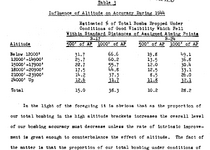drgondog
Major
Too simplistic. The combination of low loss rate betwee Aug 42 and May 1943, and faulty Intelligence assessments of LW losses attacking 8th AF presented a rational view that a.) losses were at an acceptable rate, b.) loss percentage tracked inversely to the strength of the attacking formations, c.) that 8th AF could win a war of attrition.#1 Far more success than others who thought it was suicidal? Rhetoric aside, what's your actual benchmark for success, when comparing heavy losses to strategic achievement?
The losses were demonstrably large and unsustainable - and that was the 8ths own assessment. The only way to limit them was to keep raids to within the then limited range of the available fighter cover and to keep flight times over occupied Europe short. When they eventually ventured further forth over the Reich proper in 1943 under 'Pointblank', the losses were so high (something like 20% of aircrew killed or wounded) that the 8th had to suspend operations. I'm struggling to think of very much which could be deemed a 'success' to offset that before escorted raids in '44, can you?
As for 'suicidal'? I suppose it depends on your personal appetite for risk and sense of mortality. But an airman serving in the 8th in the 1943 period knew that statistically, the odds were against them surviving even a single tour of operation. Thats a pretty close comparison, I would have said.
Raids only recommenced when fighter escort became available. And no, this critique is NOT with the 'benefit of hindsight'. The USAAF only had to look at what happened to the Luftwaffe during the BoB. And it could have looked at (and listened to) the two and a half year's worth of direct war experience of the RAF - who advised them at the time of the capability of the Luftwaffe and had long since been on the receiving end of it. Instead, political, doctrinal and material limitations lead them to relearn those lessons again. Maybe that was worth-while in itself, but it cost a lot of arguably avoidable lost-lives for what looked and still looks like little return for that sacrifice.
Intelligence failures included lack of visibilty to LW transfers from Ost and Sud fronts to Germany. For whatever reason Eaker believed that the primary defenses were aligned as an 'outer ring' which, upon penetration would dramatically reduce fighter opposition until the return. In any case, only the P-38 presented the opportunity to escort to and past the 'ring' - but had been removed from his comand in fall 1942. The replacement was the much shorter ranged P-47 with neither belly shackles or wing fuel feed for existing tanks being produced - only the 200gal ferry tank with proprietary 'one of' Republic belly mount.
Other factors that inflenced 'fight with what we have', were a.) belief that no s/e fighter could carry enough internal fuel fraction to be able also have sufficient perfomance to battle successfully with s/e interceptors, b.) the ENTIRE logistics chain was exclusvely dedicated to the doctrine of daylight attacks, ranging from targeting technologies, aircrew formation flying, dependencies upon favorable visibility for operations , c.) that construction of additional Lockheed mfg centers to increase P-38 deliveries were forecast to start deliveries in 1945.
If you refer to 9-27-44 Kassel raid where the 2CBW mysteriously branched at the IP (and escorting 4th FG did not follow) toward Gottingen, it was the worst single unit/single disaster inflicted by LW - but not the only one. The July 7 Bernburg losses are another example, for the same reason save missed R/V by 4th FG.#2 The Kassel raid on 1-2 April 44 where a raid went in without its escort due to a series of errors showed exactly how unescorted raids remained horribly vulnerable. Indeed the USAAF suffered its worst proportional losses of the entire bombing campaign on this raid. It merely underlined the lesson: strategic bombing by aircraft with a significantly lower speed and overall performance than defending fighters CANNOT 'slug it out' in a box formation and inflict enough losses to favourably attrite any enemy equipped with modern fighters in any number (and especially when operating under good radar direction). Adding yet more .50s eventually drops speed (meaning the aircraft is an easier target which is spending more time under threat), lowers bombload (meaning its less likely to achieve its bombing objective) and simply puts more flesh in the path of concentrated groups of 13, 15, 20 and 30mm shells. And in the grim economics of war, those are also human beings into whom a large amount of expensive and time consuming training has also been invested.
Your point about vulnerability is true, but Blitz Week, Tidal Wave and Schweinfurt-Regensburg brought the lessons home a year earlier.
The daylight raids were not 'suspended' by LW as much as bad weather over the continent, but Bremen and Kiel remained as tagets (some successfully escorted by 55th FG P-38s, but no P-47s)As envisaged and promoted by the designers and strategists, the self-defending daylight strategic bomber was a proven bogus philosophy. Underlined, proven unambiguously and in triplicate - a lesson evidenced that, aside from early B36 models, western bombers designed post-war concentrated on speed, altitude performance (be that high or low), counter-measures and offensive load.
Why unescorted raids over Germany were suspended

